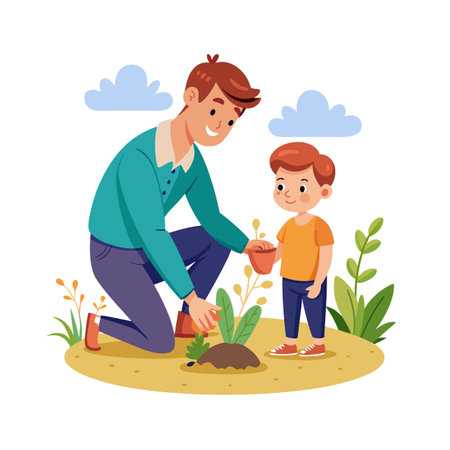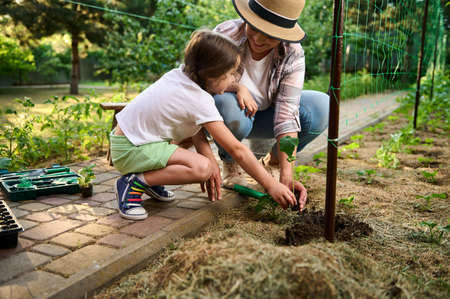1. Creating a Safe and Accessible Garden Space
When planning a garden for families, it’s important to think beyond just what plants to grow. A well-thought-out layout ensures that everyone—from toddlers to grandparents—can enjoy the space safely and comfortably. Here are some key elements to consider when designing a family-friendly garden:
Designing Pathways for All Ages
Pathways are essential for guiding movement and making the garden easy to navigate. Choose materials that are slip-resistant and wide enough for strollers or wheelchairs. Keep paths level and free from obstacles like protruding stones or uneven bricks.
| Pathway Material | Pros | Cons |
|---|---|---|
| Gravel | Affordable, easy to install | Can shift over time, not ideal for wheelchairs |
| Pavers | Durable, smooth surface | May need leveling over time |
| Concrete | Very stable, wheelchair-friendly | More expensive, permanent |
Incorporating Raised Garden Beds
Raised beds make gardening easier for people of all ages. They reduce bending and can be designed at different heights to suit kids, adults, and seniors. Make sure there’s enough space between beds for easy movement—even with a walker or stroller.
Recommended Bed Heights by Age Group:
| User Group | Ideal Height (inches) |
|---|---|
| Children (5-10 yrs) | 12–18 inches |
| Adults | 24–30 inches |
| Seniors/Seated Gardeners | 30–36 inches |
Creating Comfortable Seating Areas
A garden should be a place where the whole family can relax. Include shaded seating areas where parents can watch their kids play or where grandparents can rest. Benches with back support and armrests are especially helpful for older adults.
Tips for Family-Friendly Seating:
- Add cushions or weather-resistant pads for comfort.
- Select materials like wood or recycled plastic that stay cool in the sun.
- Place seating near fragrant plants or flowering beds to enhance relaxation.
Safety First!
No matter how beautiful your layout is, safety should always come first. Avoid sharp-edged planters, keep tools out of reach of children, and ensure there’s good lighting if the garden is used in the evening hours.
Quick Safety Checklist:
- No tripping hazards on walkways.
- Toxic plants kept out of children’s reach.
- No standing water where mosquitoes can breed.
- Cushioned ground surfaces near play areas.
A safe and accessible garden brings joy to every generation. With thoughtful design choices, you’ll create a space where memories can grow alongside your plants.
2. Choosing Kid-Friendly Plants and Features
When planning a garden with kids and families in mind, choosing the right plants and features is key to creating a space that’s both safe and exciting. Kids love to explore, touch, and play—so your garden should be filled with elements that spark curiosity while keeping safety in mind.
Non-Toxic and Safe Plants
The first rule when gardening with children is to select non-toxic plants. Some common garden plants can be harmful if ingested or touched, so its important to do your research. Heres a simple guide of kid-safe plants:
| Plant Name | Why Its Great for Kids |
|---|---|
| Sunflowers | Tall, bright, and fun to grow; great for building sunflower houses |
| Snapdragons | Colorful blooms that “snap” open—fun for little hands |
| Nasturtiums | Edible flowers with vibrant colors; easy to grow |
| Sugar Snap Peas | Tasty treats straight from the vine; perfect for healthy snacking |
| Lamb’s Ear | Soft, fuzzy leaves that kids love to touch; great for sensory gardens |
Visually Engaging Plants
Bright colors, interesting shapes, and fast-growing varieties help keep kids engaged. Mix flowers, herbs, and veggies in playful combinations to teach children about biodiversity and nature’s variety.
Tips for Visual Appeal:
- Use bold colors like red zinnias, orange marigolds, or purple petunias.
- Include fast growers like radishes or sunflowers to show quick results.
- Add climbing vines on trellises or teepees for vertical interest.
Interactive Garden Features
A kid-friendly garden goes beyond just plants. Interactive features allow children to play, learn, and connect with nature in fun ways.
| Feature | Description |
|---|---|
| Butterfly Garden | Plant milkweed, coneflowers, and lavender to attract butterflies; teaches pollinator importance. |
| Sensory Path | A walkway made of different textures like stones, bark, and grass to stimulate touch and balance. |
| Sunflower House | Create a “living fort” by planting tall sunflowers in a circle; fun hideaway for imaginative play. |
| Mud Kitchen Area | A small outdoor setup with pots, pans, and soil where kids can pretend-cook using natural ingredients. |
Encouraging Exploration Through Design
Create winding paths or hidden nooks to invite adventure. Use stepping stones or logs as natural play structures. Keep things low to the ground so little ones can interact easily with plants and features around them.
Remember:
- Avoid sharp-edged tools or thorny plants near childrens zones.
- Select raised beds or container gardens for easier access and fewer messes.
- Label plants with fun signs to make it educational too!
A thoughtfully designed family garden can be both beautiful and functional—a space where kids feel free to explore while learning about the natural world around them.

3. Incorporating Learning and Play Elements
Designing a family-friendly garden isnt just about plants—its about creating a space where kids can play, explore, and learn. By integrating fun and educational zones into your garden layout, you can spark curiosity and help children connect with nature in meaningful ways. Below are some ideas to consider when planning these spaces.
Vegetable Patches for Hands-On Learning
Creating a small vegetable patch introduces kids to how food grows and gives them the chance to participate in planting, watering, and harvesting. Choose easy-to-grow veggies like carrots, cherry tomatoes, or snap peas. Keep the area accessible with raised beds or low borders, so little hands can reach comfortably.
Kid-Friendly Vegetable Ideas
| Vegetable | Why It’s Great for Kids |
|---|---|
| Cherry Tomatoes | Easy to grow; sweet taste encourages snacking |
| Carrots | Fun to pull from the soil; teaches patience |
| Snap Peas | Crispy and sweet; great for sensory experience |
Labeled Plant Zones for Exploration
Create themed areas like a “Pollinator Garden” or “Herb Corner,” and label each plant with colorful signs. This not only helps kids learn plant names but also makes your garden feel like an outdoor classroom. You can use waterproof tags or make DIY signs together as a fun craft project.
Example Label Themes
| Zone Name | Plant Examples |
|---|---|
| Pollinator Paradise | Milkweed, Coneflowers, Lavender |
| Pizza Garden | Basil, Oregano, Tomatoes |
| Sensory Spot | Lamb’s Ear, Mint, Lemon Balm |
Digging Areas for Free Play
A designated digging zone lets younger kids enjoy unstructured play while staying within garden boundaries. Use soft soil or sand and provide kid-safe tools like small shovels and buckets. These areas support creativity and fine motor skills development while allowing kids to imitate what they see adults doing in the garden.
Tips for a Successful Digging Area:
- Place it near shade or add a canopy for sun protection
- Add logs or stones around the edge to define the space
- Include buried “treasures” like painted rocks for extra fun
By blending learning opportunities with imaginative play zones, your family garden becomes more than just a backyard—it turns into an engaging environment where curiosity blooms alongside your plants.
4. Designing Zones for Family Activities
When planning a family-friendly garden layout, its important to think beyond plants and flowers. Creating dedicated zones where families can spend quality time together encourages bonding, creativity, and outdoor fun. Here are some simple ideas for setting up activity zones that support teamwork and create lasting memories.
Picnic Area
A cozy picnic area invites everyone to enjoy meals outside. Choose a shaded spot under a tree or install a pergola for comfort during sunny days. Add a picnic table or a few weather-resistant blankets and cushions for a relaxed vibe.
Tips for Setting Up:
- Use mulch or gravel as ground cover to keep the area clean and mud-free.
- Add string lights or solar lanterns for evening ambiance.
- Keep a storage box nearby with reusable utensils, plates, and napkins.
Storytelling Corner
This zone can be magical for kids and adults alike. All you need is a quiet corner with comfortable seating and maybe a little shade. A small bench, tree stumps, or even oversized outdoor pillows work well here.
Ideas to Make It Special:
- Create a little “stage” with stepping stones for kids to act out stories.
- Install a chalkboard wall or leave notebooks nearby for drawing and writing tales.
- Decorate with whimsical elements like fairy lights or garden gnomes.
Craft Zone
An outdoor craft area lets kids explore their creativity while staying connected to nature. This space doesn’t have to be fancy—a sturdy table with easy-to-clean surfaces works just fine. Place it near the garden so kids can use leaves, rocks, and flowers in their projects.
Suggested Craft Supplies:
| Item | Purpose |
|---|---|
| Child-safe scissors and glue | Basic crafting tools |
| Nontoxic paints and brushes | For painting rocks or plant markers |
| Popsicle sticks & twine | Build mini trellises or signs |
| Baskets for found objects | Collect leaves, petals, pebbles |
The Power of Purposeful Spaces
By designing specific zones within your garden that cater to different activities, youre not just creating a beautiful outdoor area—you’re building an environment where your family can connect, learn, and grow together. These zones help make the garden a place everyone wants to spend time in, from toddlers to grandparents.
5. Encouraging a Sustainable Gardening Mindset
Designing a garden with kids and families in mind isnt just about fun and play—its also a great opportunity to teach valuable life lessons. By introducing sustainable gardening practices early on, we can help children grow into environmentally responsible adults. Here are some simple and engaging ways to build eco-friendly habits right into your family garden layout.
Composting: Turning Scraps into Soil
Composting is an easy and hands-on way for kids to learn how nature recycles. Set up a small compost bin in the garden where they can toss fruit peels, veggie scraps, and leaves. Watching these turn into rich soil is like magic for little ones—and it helps reduce household waste too!
What Can Go Into the Compost Bin?
| Green Materials | Brown Materials |
|---|---|
| Fruit and vegetable scraps | Dried leaves |
| Coffee grounds | Shredded newspaper |
| Grass clippings | Sawdust (from untreated wood) |
Water Conservation: Smart Ways to Save
Kids love helping out with watering, so its a perfect time to teach them about using water wisely. Consider adding features like rain barrels or drip irrigation systems to your garden layout. These not only conserve water but also make watering more efficient and fun.
Kid-Friendly Water-Saving Tips:
- Water early in the morning: Less evaporation means plants get more moisture.
- Use mulch: It keeps soil cool and holds in moisture.
- Create zones: Group plants with similar water needs together.
Create a Pollinator-Friendly Garden
A pollinator-friendly space is not only beautiful but essential for healthy ecosystems. Encourage kids to plant flowers that attract bees, butterflies, and hummingbirds. This teaches them how every part of nature plays a role in growing food and keeping our environment balanced.
Pollinator Plants Kids Can Grow:
| Plant Name | Attracts |
|---|---|
| Zinnias | Butterflies |
| Lavender | Bees |
| Bee Balm | Hummingbirds & Bees |
Nurturing Environmental Stewards at Home
Your backyard can be a living classroom. When you involve kids in sustainable practices, youre teaching them that even small actions—like saving kitchen scraps or choosing the right plants—can have a big impact on the world around them. With thoughtful garden layout planning that includes these elements, families can grow closer while growing greener together.


